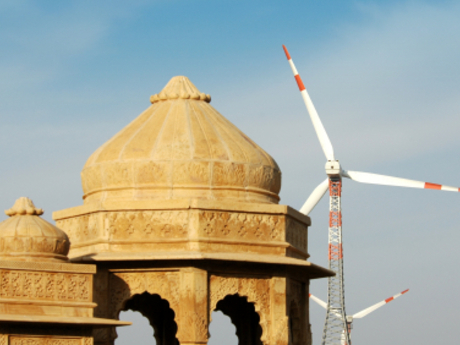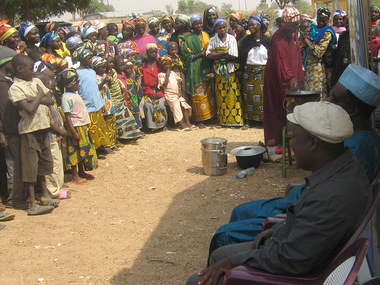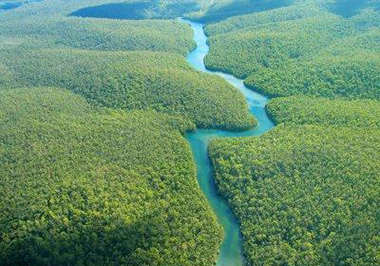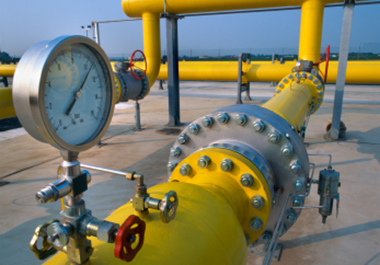Renewable energies
Renewable energy projects include hydropower, wind, sun and biomass energy projects. They have an important role in facilitating the transition from fossil to regenerative energy sources. The transition is a necessary step towards long-term reductions of carbon dioxide (CO2) emissions and a climate-friendly economy.
In a climate project involving the erection of a wind farm, the amount of emission reductions is determined by establishing how the equivalent amount of electricity would normally be produced (baseline emissions without the project). An emission factor is calculated on the basis of the composition of available power stations and recently built electricity-generating installations. The emission factor indicates how much greenhouse gas is emitted to generate a kilowatt hour of electricity. Since in most countries electricity is mainly produced by coal and other fossil fuels, the emission factor is relatively high.

If electricity is produced by a wind power station (emission situation with the project), the emission factor of the electricity mix decreases because the use of renewable energies such as wind, water or sunlight does not generate greenhouse gas emissions. Depending on the amount of electricity generated by the wind installation, emissions will be considerably reduced compared to the reference scenario without the project. The reduction in emissions can then be sold as reduction certificates for carbon offsetting. It is not always easy to decide whether a project is truly additional, that means whether it could only be carried out due to additional funding from the sales of certificates or if the project developer would have gone ahead anyway if no offsetting fees had come in. Renewable energy projects require considerable investment up front, but remain profitable in the long term.
Renewable energy projects are often established in thinly populated areas, which is why they usually have a positive impact on employment and energy supply in rural areas.
One example of a climate project using renewable energy is located in Maharashtra, India, where a wind farm with a capacity of 23.1 MW was built. The wind farm consists of 14 wind turbines, each with a capacity of 1.65 MW. They account for an annual reduction of 51,618 tonnes of carbon dioxide (CO2) per annum. Over a running period of eight years, certificates worth over 400,000 tonnes of CO2 are generated. The project runs from 2008 to 2015 and meets the Verified Carbon Standard (VCS) requirements.
Energy efficiency
While renewable energy projects make the available energy more climate-friendly, energy efficiency projects target consumption. Generally, existing technology is replaced by energy-saving technologies that achieve the same effect with less energy consumption. This can affect many areas from household products to large industrial installations.

An example of such a project is located in Nigeria, where in a number of villages, traditional three-stone fireplaces were replaced by more efficient wood burners. Energy savings of about 80 percent were made compared to a scenario without the project, leading to a significant reduction in wood burnt as fuel, which also helps stem deforestation. Thus, the project will save emissions of approximately 30.000 tonnes of carbon dioxide (CO2) annually over a 10-year period. The wood burners are assembled locally, thus having at least a positive short-term impact on local employment.
The project also has a positive effect on the health of the village population by reducing harmful smoke production and lightening the workload on women and children, who now spend less time collecting firewood. This project meets Gold Standard requirements and has also been recognized as a CDM project by the Climate Secretariat of the United Nations. The certificates generated are Certified Emission Reductions (CERs).
Afforestation and forest protection
Afforestation and forest protection projects exploit the natural capacity of plants to absorb carbon dioxide (CO2). Their objective is not the reduction of direct emissions or energy consumption. Instead, they reduce the concentration of greenhouse gases in the atmosphere by planting additional trees that will extract CO2 from the air and store it in biomass. Forest projects are also called sink projects.

Forest projects can play their part in creating incentives to prevent the felling of primary forest. Slash-and-burn practices are a major source of greenhouse gas emissions into the atmosphere. Forest protection not only leaves carbon dioxide (CO2) bound in biomass, thus preventing emissions, but also preserves the habitat of local animal species.
However, forest protection projects must be scrutinised, as planting of monocultures will displace the local plant and animal population. It is also a cause for concern if in the name of climate protection the indigenous population is denied access to certain areas.
Our example of a forest project comes from Nicaragua where trees are planted in areas that have up to now hardly been used. The trees planted are a mixture of indigenous and foreign tree species that complement each other in their needs for nutrients. The project meets Verified Carbon Standard (VCS) criteria.
Industrial gases

Industrial gases are gases (e.g. HFC-23, H2S, NH3) that are generated as a by-product of industrial production. Some industrial gases are, similar to methane, extremely damaging to the atmosphere. It is usually quite cost-effective to break down such gases and thus contribute to greenhouse gas reduction. However, projects of this type are largely controversial because, unlike energy efficiency projects, they do not achieve long-term reduction of greenhouse gas emissions. In other words, these projects are less sustainable and do not lead to long-term changes in the way the economy works. They are often short-term, one-off carbon dioxide (CO2) reduction projects.
Many experts point out that polluting industries that release large amounts of industrial gas will ultimately be rewarded for breaking down their own emissions. The sale of certificates allows them to increase their profits out of all proportion because the income from the sale bears no relation to the cost of avoiding gas production. Mostly, the income from the sale of certificates exceeds even the revenue from the end product. In addition, any positive side effects on the environment or employment are negligible.
Our example of an industrial gas project comes from Indonesia. Industrial gas generated by Sumatra’s oil industry is captured and processed for energy generation. It is mixed with natural gas and sold as energy source. This project meets Verified Carbon Standard (VCS) criteria. Thus, it is VCS-certified and saves 100,000 tonnes of CO2e per annum.
Methane
Methane is about 21 times more damaging than carbon dioxide (CO2) and is released in contexts such as agriculture, sewage treatment, landfill sites and mining. It has the same chemical composition as natural gas and can be used for the generation of energy.
There are two different types of methane projects. The first category aims at transforming methane into a less damaging gas by burning it to produce CO2 and water. The second category captures methane and uses it for electricity or heat generation. The latter happens, for example, in a climate project in China, where emissions from a regional landfill site in the Jiangsu province near the town of Suzhou are captured from drill holes and fed into a grid of pipelines. The landfill gas is then converted into electricity and fed into the local electricity grid. Greenhouse gas emissions are reduced by avoiding methane emissions into the atmosphere and substitutinng fossil energy in the local electricity grid. The project has been certified by Gold Standard VER and has additional positive effects such as creating 74 jobs in the construction and running of the installation as well as an improvement of local air quality.

